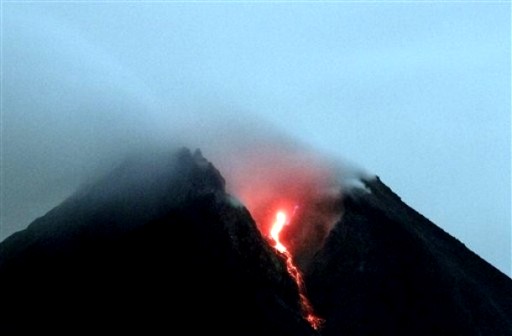October 29, 2010 (KATAKAMI / THE JAKARTA POST) --- The fisherman was jolted awake by the powerful earthquake and ran with his screaming neighbors to high ground. He said they watched as the sea first receded and then came roaring back "like a big wall" that swept away their entire village.
"Suddenly trees, houses and all things in the village were sucked into the sea and nothing was left," Joni Sageru recalled Thursday in one of the first survivor accounts of this week's tsunami that slammed into islands off western Indonesia.
The death toll rose to 370 as officials found more bodies, although hundreds of people remained missing. Harmensyah, head of the West Sumatra provincial disaster management center, said rescue teams "believe many, many of the bodies were swept to sea."
Along with the 33 people killed by a volcano that erupted Tuesday more than 800 miles (1,300 kilometers) to the east in central Java, the number of dead from the twin disasters has now topped 400. Mount Merapi began rumbling again Thursday after a lull that allowed mourners to hold a mass burial for its victims. There were no reports of new injuries or damage.
The catastrophes struck within 24 hours in different parts of the seismically active country, severely testing Indonesia's emergency response network.
Aid workers trickling into the remote region found giant chunks of coral and rocks in places where homes once stood. Huge swaths of land were submerged. Swollen corpses dotted roads and beaches.
In a rare bright spot, an 18-month-old baby was found alive Wednesday in a clump of trees on Pagai Selatan - the same island where the 30-year-old Sageru lived. Relief coordinator Harmensyah said a 10-year-old boy found the toddler whose parents are both dead.
More than 100 survivors crowded a makeshift medical center in the main town of Sikakap on Pagai Utara - one of the four main islands in the Mentawai chain located between Sumatra and the Indian Ocean.
Some still wept for lost loved ones as they lay on straw mats or sat on the floor, waiting for medics to treat injuries such as cuts and broken limbs. Outside, some rescuers wore face masks as they wrapped corpses in black body bags.
A young woman named Adek sobbed uncontrollably as she tried to talk about her year-old baby who was washed away. "Oh, don't ask me again," she said, wiping her tears and turning away.
One of the hardest hit areas with 65 dead was the village of Pro Rogat, on Pagai Seatandug island.
Villagers there huddled under tarps in the rain and told how many people who had fled to the hills were now too afraid to return home.
Mud and palm fronds covered the body of the village's 60-year-old pastor, Simorangkir. He lay on the ground, partially zipped into a body bag. Police and relatives took turns pushing a shovel into the sodden dirt next to him for his grave.
His 28-year-old grandson, Rio, traveled by boat to Pro Rogat from his home on a nearby island to check on his relatives after the quake and tsunami. He said he was picking through the wreckage when someone cried out that he had found a body.
Rio walked over and saw his dead grandfather partially buried under several toppled palm trees.
"Everybody here is so sad," Rio said, as relatives prepared to lay his grandfather in the grave.
Officials say a multimillion-dollar tsunami warning system that uses buoys to detect sudden changes in water levels broke down a month ago because it was not being properly maintained. The system was installed after a monster 2004 quake and tsunami that killed 230,000 people in a dozen countries.
A German official at the project disputed there was a breakdown, saying Monday's 7.7-magnitude quake's epicenter was too close to the Mentawai islands for residents to get the warning before the killer wave hit.
"The early warning system worked very well - it can be verified," said Joern Lauterjung, head of the German-Indonesia Tsunami Early Warning Project for the Potsdam-based GeoForschungs Zentrum. He added that only one sensor of 300 had not been working and said that had no effect on the system's operation.
At the Mount Merapi volcano, hot clouds of ash spewed from the mountain around 4:30 p.m. Thursday, according to the Indonesian volcanology agency Subandriyo.
It was unclear whether the new activity was a sign of another major blast to come.
Residents from Kinahrejo, Ngrangkah, and Kaliadem - villages that were devastated in Tuesday's blast - crammed into refugee camps. Officials brought cows, buffalo and goats down the mountain so that villagers wouldn't try to go home to check on their livestock.
Thousands attended a mass burial for 26 of the victims six miles (10 kilometers) from the base of the volcano. Family and friends wept and hugged one another as the bodies were lowered into the grave in rows.
(MS)
